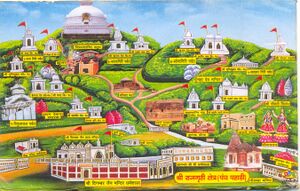Vipula
| Author:Laxman Burdak, IFS (R) |

Vipula (विपुल) is a mountain mentioned in Mahabharata and Buddhist records.
Variants
- Vipula विपुल = Vipulagiri विपुलगिरि = Vipulachala विपुलाचल (AS, p.860)
- Vipulaparvata/Vipula Parvata (विपुल पर्वत)
- Vipulachala Parvata (विपुलाचल पर्वत)
- Wepullo
- Vipula-giri
- Vepulla (वेपुल्ल) (AS, p.860)
History
Alexander Cunningham[1] mentions.... Kusagarapura was the original capital of Magadha, which was called Rajagriha, or the " Royal Residence." It was also named Girivraja, or the "hill-surrounded," which agrees with Hwen Thsang's description of it as a town " surrounded by mountains." Girivraja[2] is the name given in both the Ramayana and the Mahabharata to the old capital of Jarasandha, king of Magadha, who was one of the principal actors in the Great War, about 1426 B.C. The Chinese pilgrim Fa-Hian[3] describes the city as situated in a valley between five hills, at 4 li, or two-thirds of a mile, to the south of the new town of Rajagriha. The same position and about the same distance are given by Hwen Thsang, who also mentions some hot springs, which still exist. Fa-Hian
[p.463]: further states that the " five hills form a girdle like the walls of a town," which is an exact description of Old Rajagriha, or Purana Rajgir, as it is now called by the people.
A similar description is given by Tumour from the Pali annals of Ceylon, where the five hills are named Gijjhakuto, Isigili, Webharo, Wepullo, and Pandawo[4]
In the Mahabharata the five hills are named Vaihara, Varaha, Vrishabha, Rishi-giri, and Chaityaka;[5] but at present they are called Baibhar-giri, Vipula-giri, Ratna-giri, Udaya-giri, and Sona-giri.
In the inscriptions of the Jain temples on Mount Baibhar, the name is sometimes written Baibhara, and sometimes Vyavahara. It is beyond all doubt the Webharo Mountain of the Pali annals, on whose side was situated the far-famed Sattapanni Cave, in front of which was held the first Buddhist synod, in 543 B.C. This cave, I believe, still exists under the name of Son Bhandar, or " Treasury of gold," in the southern face of the mountain ; but following Hwen Thsang's description, it should rather be looked for in the northern face. In the Tibetan Dulva it is called the " Cave of the Nyagrodha" or Banian-tree.[6]
Ratnagiri is due east, one mile distant from the Son Bhandar Cave. This situation corresponds exactly with Fa-Hian's position of the Pippal-tree Cave, in which Buddha after his meals was accustomed to meditate.
In Mahabharata
Vipula (विपुल) (Mountain) is mentioned in Mahabharata (II.19.2)
Sabha Parva, Mahabharata/Book II Chapter 19 mentions that Krishna, Bhima and Arjuna attacked Girivraja to kill Jarasandha. Vipula (विपुल) (Mountain) is mentioned in Mahabharata (II.19.2).[7] ....The five large hills of Vaihara, Vipula, Varaha, Vrishabha, Rishigiri, and the delightful Chaityaka, all of high peaks and overgrown with tall trees of cool shade and connected with one another, seem to be jointly protecting the city of Girivraja.
विपुल = विपुलगिरि = विपुलाचल
विजयेन्द्र कुमार माथुर[8] ने लेख किया है ...विपुल = विपुलगिरि = विपुलाचल (p.860): विपुल पर्वत अथवा 'विपुलगिरि' अथवा 'विपुलाचल' राजगृह (राजगीर, बिहार) के सात पर्वतों में परिगणित है। इस पर्वत का महाभारत, सभापर्व 2,1 दक्षिणात्य पाठ में उल्लेख है- 'पाडंरे विपुले चैव तथा वाराहकेसपि च चैत्यके च गिरिश्रेष्ठे मातंगेच शिलाच्चये।'
पाली भाषा के साहित्य में इसे 'वेपुल्ल' कहा गया है। विपुलगिरि या विपुलाचल जैन धर्म के अंतिम तीर्थंकर भगवान महावीर के प्रथम प्रवचन की स्थली होने p.861]:के कारण भी प्रसिद्ध है। उन्होंने इस स्थान से बारह वर्ष की मौन तपस्या के उपरान्त श्रावण मास में कृष्ण पक्ष की प्रतिपदा की पुण्य वेला में सूर्योदय के समय अपनी सर्वप्रथम ‘देशना’ की थी, जिसमें उन्होंने कहा था- 'सब्वे विजीवा इच्छन्ति, जीवउंण मरिज्जउं, तम्हा पाणिवधं समणा परिवज्जयंतिण।' अर्थात "सभी प्राणी जीना चाहते हैं, मरना कोई नहीं चाहता। इसलिए प्राणिवाध घोर पाप है। जो श्रमण हैं, वे इसका परित्याग करते हैं।" विपुलाचल का महत्व जैन धर्म वहीं है, जो सारनाथ का बौद्ध धर्म में है।
2. विष्णुपुराण 2,2,17 के अनुसार विपुल इलावृत के चार पर्वतों ( विपुल, सुपार्श्व, मंदर, गंधमादन) में से पश्चिम की ओर का पर्वत है- 'विपुलः पश्चिमे पाश्वे सुपार्श्वश्चोत्तरै स्मृत:।'
External links
References
- ↑ Alexander Cunningham: The Ancient Geography of India/Magadha , pp.462-
- ↑ Lassen, Ind. Alterthum, i. 604.
- ↑ Beal's 'Fah-Hian,' c. xxviii. 112.
- ↑ Journ. Asiat. Soc. Bengal 1838, p. 996.
- ↑ Lassen, Ind. Alterthum, ii. 79. The five hills are all shown in Map No. XII.
- ↑ Csoma de Koros in Bengal ' Asiatic Researches,' xx. 91.
- ↑ वैहारॊ विपुलः शैलॊ वराहॊ वृषभस तथा, तथैवर्षिगिरिस तात शुभाश चैत्यक पञ्चमाः (II.19.2) एते पञ्च महाशृङ्गाः पर्वताः शीतलद्रुमाः, रक्षन्तीवाभिसंहत्य संहताङ्गा गिरिव्रजम (II.19.3)
- ↑ Aitihasik Sthanavali by Vijayendra Kumar Mathur, p.860-861

